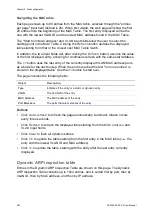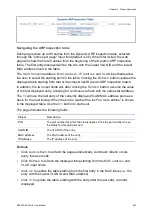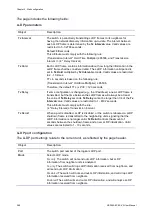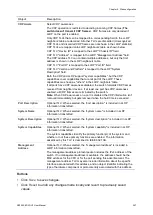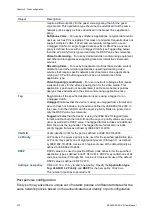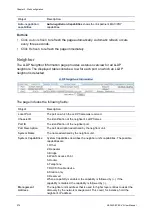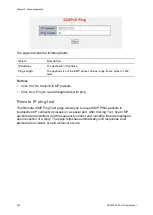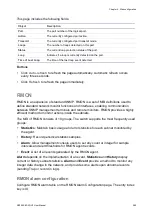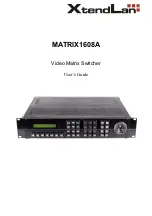
Chapter 4: Web configuration
274
NS3552-8P-2S-V2 User Manual
Object
Description
Each LLDP-MED Endpoint Device Class is defined to build upon the
capabilities defined for the previous Endpoint Device Class. For example,
any LLDP-MED Endpoint Device claiming compliance as a Media Endpoint
(Class II) will also support all aspects of TIA-1057 applicable to Generic
Endpoints (Class I), and any LLDP-MED Endpoint Device claiming
compliance as a Communication Device (Class III) will also support all
aspects of TIA-1057 applicable to both Media Endpoints (Class II) and
Generic Endpoints (Class I).
LLDP-MED Generic Endpoint (Class I)
The LLDP-MED Generic Endpoint (Class I) definition is applicable to all
endpoint products that require the base LLDP discovery services defined in
TIA-1057 but do not support IP media or act as an end-user communication
appliance. Such devices may include (but are not limited to) IP
Communication Controllers, other communication related servers, or any
device requiring basic services as defined in TIA-1057. Discovery services
defined in this class include LAN configuration, device location, network
policy, power management, and inventory management.
LLDP-MED Media Endpoint (Class II)
The LLDP-MED Media Endpoint (Class II) definition is applicable to all
endpoint products that have IP media capabilities but may or may not be
associated with a particular end user. Capabilities include all of the
capabilities defined for the previous Generic Endpoint Class (Class I), and
are extended to include aspects related to media streaming. Example
product categories expected to adhere to this class include (but are not
limited to) voice/media gateways, conference bridges, media servers, etc.
Discovery services defined in this class include media-type-specific network
layer policy discovery.
LLDP-MED Communication Endpoint (Class III)
The LLDP-MED Communication Endpoint (Class III) definition is applicable
to all endpoint products that act as end user communication appliances
supporting IP media. Capabilities include all of the capabilities defined for
the previous Generic Endpoint (Class I) and Media Endpoint (Class II)
classes, and are extended to include aspects related to end user devices.
Example product categories expected to adhere to this class include (but are
not limited to) end user communication appliances, such as IP Phones, PC-
based softphones, or other communication appliances that directly support
the end user.
Discovery services defined in this class include provision of location identifier
(including ECS / E911 information), embedded L2 switch support, and
inventory management
LLDP-MED
Capabilities
LLDP-MED Capabilities describes the neighbor unit's LLDP-MED
capabilities. The possible capabilities are:
1. LLDP-MED capabilities
2. Network Policy
3. Location Identification
4. Extended Power via MDI - PSE
5. Extended Power via MDI - PD
6. Inventory
7. Reserved
Application Type
Application Type indicating the primary function of the application(s) defined
for this network policy, advertised by an Endpoint or Network Connectivity
Device. The possible application types are as follows:
Summary of Contents for NS3552-8P-2S-V2
Page 1: ...NS3552 8P 2S V2 User Manual P N 1073552 EN REV B ISS 25JAN19 ...
Page 41: ...Chapter 3 Switch management NS3552 8P 2S V2 User Manual 39 ...
Page 73: ...Chapter 4 Web configuration NS3552 8P 2S V2 User Manual 71 ...
Page 147: ...Chapter 4 Web configuration NS3552 8P 2S V2 User Manual 145 ...
Page 511: ......



